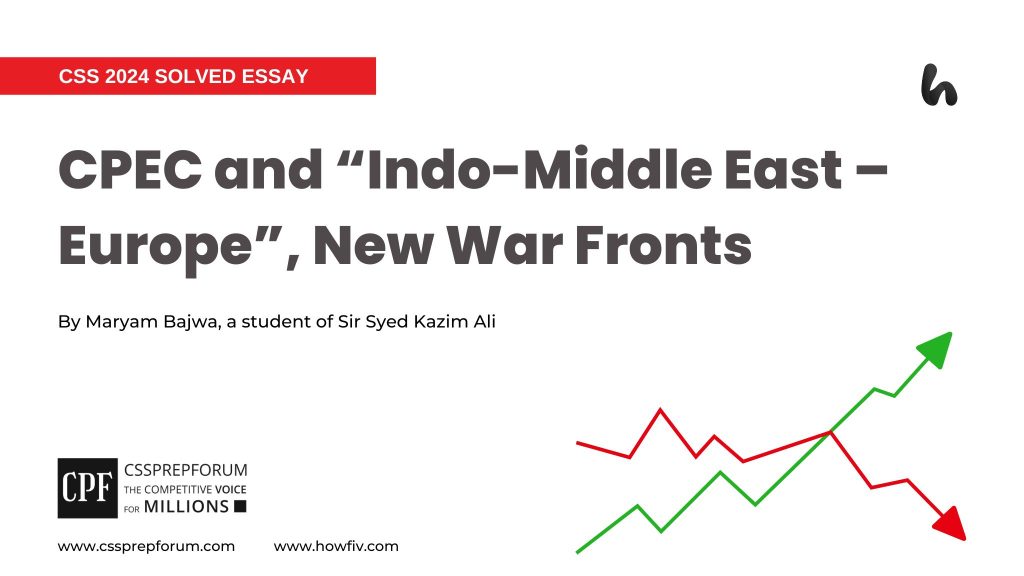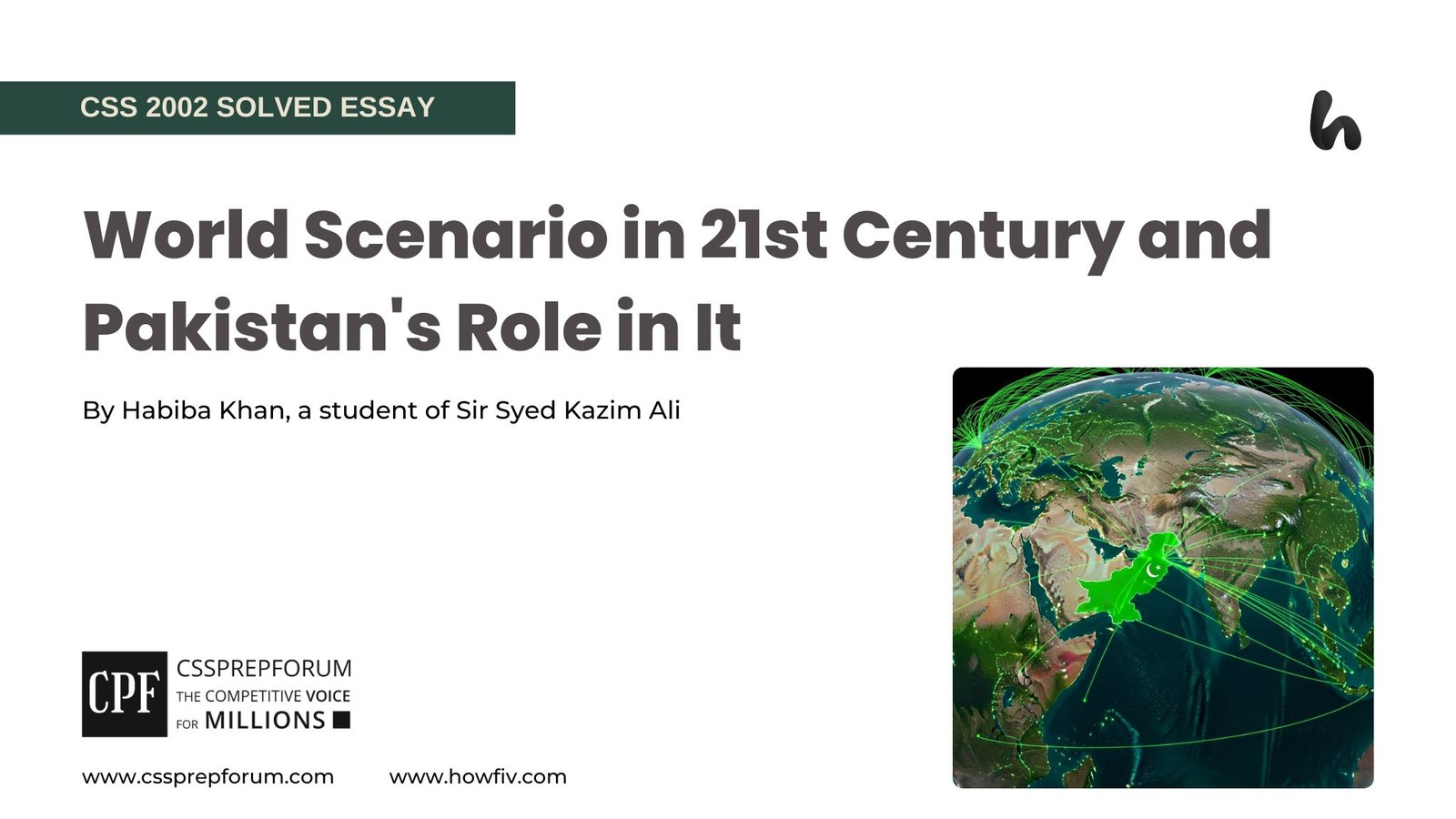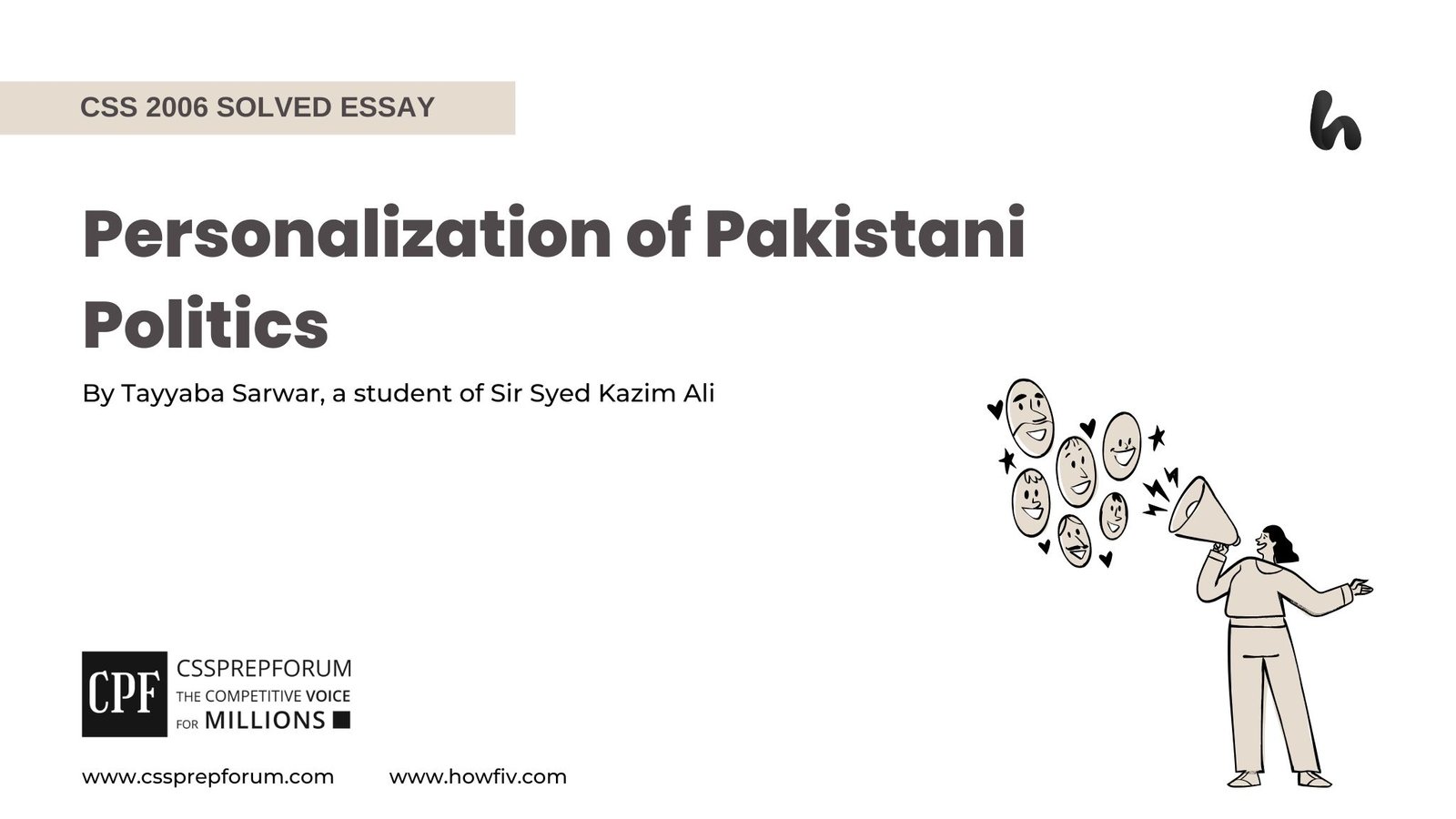CSS 2024 Solved Essay | CPEC and “Indo-Middle East – Europe”, New War Fronts
Maryam Bajwa, a Sir Syed Kazim Ali student, has attempted the CSS 2024 Solved Essay “CPEC and “Indo-Middle East – Europe”, New War Fronts” on the given pattern, which Sir Syed Kazim Ali teaches his students. Sir Syed Kazim Ali has been Pakistan’s top English writing and CSS, PMS essay and precis coach with the highest success rate of his students. The essay is uploaded to help other competitive aspirants learn and practice essay writing techniques and patterns to qualify for the essay paper.

Outline
1-Introduction
Although multi-billion-dollar projects like the Indo-Middle East – Europe (IMEC) and China-Pakistan Economic Corridor (CPEC) can offer economic prosperity and cooperation among states, especially in the Middle East and Indian Ocean Region, they also lead to the creation of new war fronts because of the ongoing struggle between the USA and China for global dominance as they both aim to control economic resources and to promote their geopolitical influence through economic projects exacerbating geopolitical tensions and economic exploitation, causing new war fronts in the Eurasian region.
2-Understanding China-Pakistan Economic Corridor (CPEC)
- ✓Historical context and inception
- ✓Strategic objectives and economic benefits
- ✓Geopolitical implications for China, Pakistan, and the broader region
3-Understanding Indo-Middle East-Europe Corridor (IMEC)
- ✓Historical context and inception
- ✓Strategic objectives and economic benefits
- ✓Geopolitical implications for India, the Middle East, Europe, and the broader region
4-The US’s real motives behind IMEC
5-The China’s real motives behind CPEC
6-How can CPEC and IMEC exacerbate existing geopolitical tensions, potentially creating new war fronts for regional and global competition?
6.1-On the region Level
- ✓Exacerbating Indo-Pakistan rivalry and creating a polarized environment
- Case in point: According to analysts, Pakistan views IMEC as a threat to its transit hub dreams, while India claims CPEC breaches its territorial integrity in Kashmir, intensifying their rivalry due to these projects.
- ✓Rising influence of two ideologies, especially in the Middle East
- Case in point: The Gulf region is the important geopolitical landscape for both China and the USA to secure their oil resources and routes, which indicates the competition to influence the region and trade roots.
- ✓Rising militarization in the Arabian Sea and Indian Ocean to capture geo-economic resources
- Case in point: The militarization of the US and China in the South China Sea transformed into CPEC and IMEC, showcasing the changing nature of war fronts and raising armaments in the Arabian and Indian Oceans.
- ✓Creating competition between China and India as they both want to attain a leading power in the region
- Case in point: India’s growing explorations in the South China Sea in Vietnam EEZ are the result of CPEC; through IMEC, India aimed at a regional power that insecure China, exposing the ongoing power tussle between both countries.
6.2-On the Global Level
- ✓Intensifying China-USA rivalry on a larger scale due to CPEC and IMEC
- Case in point: The US project IPEF aims to stop expanding China in the Indo-Pacific; as China claims, the US launched IMEC without being part of it, showcasing the geopolitics between Countries
- ✓CPEC and IMEC would create a technological race to attain digital dominance
- Case in point: The US formed the Chip Alliance with Japan and Taiwan (Chip 4) to block China’s chip industry, cutting off 14-17 nm tech, intensifying US-China rivalry.
- ✓Energy security and resource competition on a global scale intensify geopolitical tensions
- Case in point: China’s CPEC offers a shorter oil import route bypassing the Strait of Malacca, alarming India and the USA. Meanwhile, IMEC gives India and Europe direct Middle East access, fueling resource competition.
- ✓Divergence of opinion in Europe on CPEC and IMEC led to the creation of new alliances around the globe
- Case in point: The Middle East and EU welcome IMEC and CPEC to diversify economies, but China and the USA push nations to join their blocs, leading to the creation of new alliances.
7-On what grounds do opponents argue that CPEC and IMEC cannot create economic war fronts?
- ✓Counter Argument: IMEC and CPEC promote stability in the region, especially in the Middle East, a hub of rivalries and power struggles.
- Refutation: CPEC and IMEC create economic war fronts instead of economic integration and stability as both try to contain each other’s sway and bypass the other’s corridor, aiming to secure energy resources.
- Evidence: Almost 50% of the world’s oil reserves are located In the Gulf region, which fascinates superpowers to secure their energy needs by building corridors in the form of IMEC and CPEC, which heightened the economic battlefronts and fragmented the economic landscape.
- Refutation: CPEC and IMEC create economic war fronts instead of economic integration and stability as both try to contain each other’s sway and bypass the other’s corridor, aiming to secure energy resources.
- ✓Counter Argument: IMEC and CPEC projects try to pull the Global South out of the quagmire of under-development and lead them to a new pace of development.
- Refutation: The projects IMEC and CPEC are driven by two counter ideologies that want to drain out all resources of the Global South and leave them into a new regional and global rivalry, creating disunity and a sense of isolation.
- Evidence: The US’s exploitation of Venezuela’s oil reserves made Venezuela dependent on American will; similarly, China’s control over Zambia’s copper and extended influence in its political sphere underscore the reality behind IMEC and CPEC projects.
- Refutation: The projects IMEC and CPEC are driven by two counter ideologies that want to drain out all resources of the Global South and leave them into a new regional and global rivalry, creating disunity and a sense of isolation.
8-Critical Analysis
9-Conclusion

In the rapidly evolving landscape of global trade and geopolitics, economic corridors have emerged as vital conduits of commerce and strategic influence. Among these, the China-Pakistan Economic Corridor (CPEC) and the newly proposed Indo-Middle East-Europe Corridor (IMEEC) stand out as monumental projects with significant strategic importance. CPEC, positioned as a flagship initiative of China’s Belt and Road Initiative (BRI), seeks to bolster connectivity and promote economic collaboration between China and Pakistan, extending its influence across the region. In contrast, the IMEEC is a collaborative initiative that brings together India, nations in the Middle East, and Europe in a collective effort to establish an alternative trade route that counters the strategic dominance of CPEC. These corridors transcend their roles as mere infrastructure projects; rather, they epitomize new geopolitical and economic battlegrounds. As nations compete for influence and control over these pivotal routes, the potential impacts on regional stability, international relations, and global trade dynamics are profound. The emergence of CPEC and the Indo-Middle East-Europe Corridor signifies new geopolitical and economic battlegrounds, with potential implications for regional stability, international relations, and global trade dynamics.
Before moving down, it is important to understand the China-Pakistan Economic Corridor (CPEC). Historically,China finds an alternative route to the Strait of Malacca due to concerns about disruption and blockade during times of regional tensions or conflicts in its maritime route. Therefore, CPEC was initiated in 2013, connecting China’s Xinjiang region to Pakistan and the rest of the world, aiming to secure its strategic interest and oil import trade from the Gulf region. Strategically, CPEC provides a cost-effective and time-saving shortest route to China for oil imports from the Middle East, promoting regional cooperation, increasing employment opportunities in Pakistan, and a skyrocketing boost to Pakistan’s economy. Geopolitically,the project creates rivalry between China and India because its route passes through the disputed territory as per India’s claim and seen it as against its territorial sovereignty. The project also increases the debt burden and affects Pakistan’s sovereignty. Thus, it also shapes the global and regional dynamics of its influence strategy by heavily investing in the infrastructure of different developing countries.
Delving more to understand the other counterpart IMEC, it is vital to know about the historical and current dynamics. In terms of its origins, IMEC, launched at the September 2023 G20 summit in New Delhi, aims to bolster its connectivity from India to Europe through the Middle East. Eight countries have signed the initial memorandum of understanding. From a strategic viewpoint, the project aims to enhance India’s growing power in the region by countering China’s growing sway as an emerging economy. Further, it aims to connect Europe to the Middle East to reduce its oil dependence on Russia and minimize the differences between Israel and Arab nations. It also seeks to enhance infrastructure development, connectivity, and technological advancement. Regarding broader geopolitics, IMEC enhances the rivalry between regional key players, potentially altering the geopolitical dynamics of the Middle East in the ongoing Israel-Palestine conflict and increasing India’s regional influence. However, it may foster economic integration and cooperation through diverse, interconnected corridors and a free trade system.
Jumping directly towards the maxim without knowing the real motives of the US behind IMEC is worthless. The motives are multifaceted and strategic. Primarily, the country aims to counter China’s growing influence in the region, which has been aggravated more since China played the role of mediator between Iran and Saudi Arabia. Likewise, China’s growing potential through its multi-dimensional BRI project, especially CPEC, has threatened the US’s sway in Asia. The US seeks to enhance regional cooperation through the project that creates new markets for American business. Additionally, Russia threatens the whole of Europe by cutting its oil exports to Europe due to increasing sanctions by USA and EU. Therefore, the USA seeks to establish a connectivity link between Europe and the Middle East to settle this issue.
Looking towards the motives of China behind CPEC, the country is to reduce the cost of its oil import from the Middle East, in which Pakistan provides a shorter and safer route to China for energy resources. Likewise, China has also developed its western region through CPEC. The project also aims to strengthen its ties with the Gulf Region and seeks to develop digital infrastructure. It also increases regional cooperation, integration and unity among states and creates China’s supremacy in the region. Further, China aims to portray its image as an emerging peacekeeping superpower that could replace the USA’s hegemony globally.
Moving towards providing the maxim, new war fronts lie in economic zones. CPEC and IMEC have fueled India and Pakistan’s historic rivalry. According to the analysts, Pakistan has seen IMEC as a threat to its dream of a transit hub. On the other hand, India’s claim that the CPEC breaches India’s territorial integrity by passing through the disputed region of Kashmir showcased the rivalry between the two countries has intensified further due to these projects. Further, it elaborates that Pakistan aims to become a transit hub, but its value can be undermined if IMEC gives its full potential to the Eurasian region. Likewise, Indian officials claim CPEC passes through disputed territory that also creates a threat to India’s sovereignty, leading to rising tensions between both countries and increased military activities on borders, affecting both the country’s geopolitical and geostrategic interests to play the crucial role in the region, which increases competition between rival nations. Hence, the economic projects exacerbate tensions between hostile neighbours, creating unrest.
Adding more to it, the Middle East region, full of natural resources, has always attracted the world’s attention, especially superpowers like China and the USA, which has also increased their influence in the region of their interest to drain out the natural resources of oil and the natural gas reserves. Some researchers have shown that the Gulf region is an important geopolitical landscape for China and the USA to secure their oil resources and routes, indicating the competition that influences the region and its trade roots. In addition, China has introduced CPEC, and the USA has introduced IMEC to secure their access to energy through routes, which also increases resource exploitation and leads to socio-economic instability in the region, which increases competition for power balance between superpowers. Thus, the rising influence of superpowers in the Middle East increases rivalry, creating a situation of unrest in the region.
Moreover, CPEC and IMEC contribute to escalating tensions to secure economic resources of Eastern Europe to gain access to the world, which could increase militarization in the Eurasian Sea, which aims to gain access to maritime resources. The recent militarization of the US and China in the South-China Sea indicates that the game is now shifting from the military to the economic front in the form of economic corridors that would raise armaments in the Arabian and Indian Oceans to gain and protect geo-economic interests. Likewise, CPEC passes through the Arabian Sea – the shorter route to reach the Middle East – and IMEC moves through the Indian Ocean, which may lead to naval presence and continuous patrolling in the region to protect the trade, which further increases the risk of piracy and state-owned attacks. Hence, the projects heightened regional tensions and endangered the security of traditional and modern shipping lanes.
Lastly, from a regional point of view, China and India are the leading economies of Asia and are hostile neighbours of each other due to territorial and border tensions. Similarly, the initiation of CPEC enhances China’s role and connectivity in the region; IMEC aims to bolster India’s ties with the Middle East and Europe. Therefore, both countries see each other from a competitor’s point of view. India’s growing explorations in the South China Sea in Vietnam EEZ resulted from CPEC; through IMEC, India aimed at a regional power that insecure China, exposing the ongoing power tussle between both countries. The competition intensifies when both countries seek to disrupt each other’s infrastructural investments, leading to a power tussle and instability in the region. So, the projects lead to regional rivalries between countries due to excluding many major countries and potentially creating power struggles.
From the global point of view, IMEC and CPEC intensify the rivalry between the USA and China on a worldwide scale. China maintains a strong foothold in the Asian region through CPEC and BRI by connecting many member states as its partners. In response, the USA used its economic card IMEC to counterbalance China’s influence. As per China claims, the US itself isn’t part of the IMEC but launched the project to counter China’s influence; the USA projects IPEF (Indo-Pacific Economic Framework) surrounded China with the member countries to isolate China showcased the global geopolitics between the USA and China. Additionally, both countries claim each other’s project as nonsense, where China connects the whole world in the net of trade and debt. On the other hand, the USA formed a coalition with all countries of neighbouring China and used it to isolate China. Therefore, both projects not only remain limited to regional rivalry but also engage the whole world in the quagmire of wars, exacerbating tensions and changing global dynamics.
Stepping next to it, CPEC and IMEC could create technological competition across the globe. CPEC promotes digital connectivity by providing data flow and an e-commerce market system. On the other hand, IMEC enhances digital infrastructure and cybersecurity to counter the Chinese as the USA claims that the Chinese have stolen intellectual property and trade secrets of the USA. For instance, the United States organized the Chip Alliance between the United States, Japan, and Taiwan (Chip 4), which aims to impose a complete blockade on China’s chip manufacturing industry by cutting off the supply of 14-17 nm chip design and manufacturing equipment and software. This underscores the digital competition between the USA and China through IMEC and CPEC projects, bolstering their digital tussle to influence the global digital landscape. This further intensifies the tensions between states and creates dependency on superpowers. Therefore, both projects indulge in a digital race that contributes to a threat to all nations and alters the future balance of power in the world.
Further, in the globalized world, every nation tries to secure its energy routes to fulfil its energy needs. Due to this, energy security and energy competition on a global scale have intensified geopolitical tensions. CPEC as a shorter route for China to secure its oil import from the major oil nations by bypassing the Strait of Malacca alarmed India and the USA; meanwhile, IMEC provides a direct route for India and Europe to approach the Middle East, creating a polarized environment over resource competition. In addition, through economic projects, superpowers aim to control energy resources to dominate the world and boost their economic benefits, which leads to creating polarized situations that underscore world peace. Thus, superpowers have used economic projects for resource exploitation that could cause geopolitical rivalry at the global level.
Last but not least, CPEC and IMEC also lead to divergence of opinions in Europe because many countries are trading partners of China at a larger level. For this, European countries aim to join CPEC to secure their interest by maintaining neutrality. Likewise, some countries aim to join IMEC to secure their energy routes because they don’t solely depend on Russian oil. The Middle East and EU countries open doors for both IMEC and CPEC projects to advance their economies without being overly dependent on any single superpower. However, China and the USA try to force countries to join either block, which leads to new alliances. Further, it shows that Eurasian countries don’t show interest in depending heavily on a single project, but the changing geopolitical pressure could create divergence between EU countries. Nevertheless, rivalry between superpowers has fragmented the countries to join one alliance, either the USA or China, creating global unrest. Thus, divergence of opinions among countries led to the creation of alliances of a new era as the world has divided during the Cold War.
Going down the ladder, every coin has two sides. Opponents argue that IMEC and CPEC are two economic projects that bring stability to the Middle East, a hub of rivalries and power struggles. However, opponents overlooked the other strong side of the coin, which is the bone of contention of all rivalries. CPEC and IMEC have created economic war fronts instead of economic integration and stability as they try to contain each other’s sway and bypass the other’s corridor, aiming to secure energy resources. Almost 50% of the world’s oil reserves are located in the Gulf region, which fascinates superpowers to secure their energy needs by building corridors in the form of IMEC and CPEC that heightened economic battlefronts and fragmented the economic landscape. Moreover, it shows superpowers use those countries that are rich in natural resources to gain benefits and increase competition for resources, which not only leads to the exploitation of resources but also harms their sovereignty by influencing them. Thus, competition between Superpowers has heightened the economic race and fragmented the economic landscape, undermining regional stability and integration that disapproving opponents’ arguments.
By the same token, every debate has two opposite views. Opponents argue that CPEC and IMEC projects have been constructed to endorse connectivity between the developing and developed nations to pull the Global South out of under-development, bolstering it with the new pace of development and growth. However, opponents have overlooked the other side of the debate that exhibits the nature of these projects announced by the two separate ideologies, which remain rivals throughout history, aiming to secure their own interests and power game by draining out all resources of the Global South. For instance, the US’s exploitation of Venezuela’s oil reserves makes Venezuela dependent on American will; similarly, China’s control over Zambia’s copper and extending its influence in its political sphere underscores the reality behind IMEC and CPEC projects. It is evident from the above evidence that IMEC and CPEC are a way of tapping the resources under the thumb of superpowers, leaving them in disunity and a sense of isolation. Hence, it creates a cycle of dependency in which developing countries grapple with many issues.
Critically, CPEC and IMEC projects are economic and strategic due to their potential for competition. They fight over their strategic interests instead of preferring regional cooperation that only generates rivalry. The number of corridors made historically, like the North-South corridor, which connects India to Russia by Iran, was signed in 2002, but even today, it is under construction and not fully operational. Likewise, it is the reality of these economic projects, nothing more than a mere source of completing their interests. Like this, the CPEC and IMEC are just a golden dream of advancement and innovation, but in reality, they just work on their selfish interests by stealing the resources of developing nations.
Conclusively, the China-Pakistan Economic Corridor (CPEC) and the Indo-Middle East-Europe Corridor (IMEC) are not just trade routes, but they embody broader geopolitical strategies with significant implications for regional stability and global power dynamics. These initiatives signify a shift from traditional military confrontations to economic and strategic competition in contemporary geopolitics. CPEC strengthens China’s access to crucial energy resources and amplifies its geopolitical influence. At the same time, IMEC counterbalances China’s increasing influence, bolstering the strategic importance of India and the Middle East. These projects exacerbate existing rivalries, particularly between India and Pakistan, and intensify the geopolitical competition between the United States and China. The corridors could lead to heightened militarization and digital competition, impacting the global power balance. While proponents emphasize their economic benefits, the underlying strategic motives indicate a complex interplay of interests that might give rise to new areas of conflict and rivalry on regional and global scales.

CSS Solved Past Papers’ Essays
Looking for the last ten years of CSS and PMS Solved Essays and want to know how Sir Kazim’s students write and score the highest marks in the essays’ papers? Then, click on the CSS Solved Essays to start reading them.
CSS Solved Essays
CSS Solved General Science & Ability Past Papers
Want to read the last ten years’ General Science & Ability Solved Past Papers to learn how to attempt them and to score high? Let’s click on the link below to read them all freely. All past papers have been solved by Miss Iqra Ali & Dr Nishat Baloch, Pakistan’s top CSS GSA coach having the highest score of their students.












